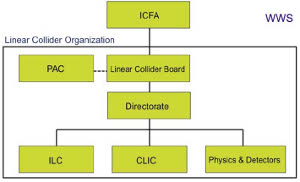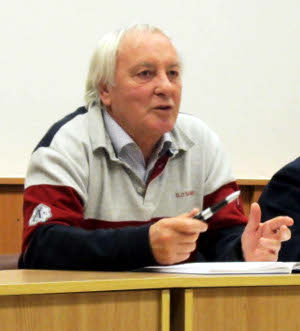
Lyn Evans will direct the new Linear Collider Directorate that will include ILC, CLIC and Detector/Physics components
As we approach the final stages of the work of the Global Design Effort, we have been simultaneously assembling a very solid Technical Design Report that could be used as the basis of a construction proposal, while at the same time helping set the stage for the next steps towards an ILC. The next steps will involve continuing the worldwide R&D programme, especially the R&D on high-gradient superconducting radiofrequency cavities and the systems test programmes. In addition, there will be continuing work on physics, industrialisation as well as towards siting the project. The International Committee for Future Accelerators ICFA announced yesterday that in the new organisation (see chart), the new Directorate will be headed by Lyn Evans. He has a broad mandate that will include more integration of the continuing ILC R&D, the alternative CLIC Linear Collider technology R&D and the ongoing work towards Linear Collider (LC) physics and detectors.
Lyn Evans brings many years of experience with particle accelerators from CERN, and especially from his role as Project Leader for the LHC during its formative days. Lyn is also very familiar with the R&D carried out for the ILC and design programmes because he has served since 2009 as chair of the ILCSC Project Advisory Committee (PAC) that conducts ongoing reviews of our technical work. Through that role, Lyn has become very well informed regarding all our work towards the Technical Design Report. In addition, the PAC will be the first to receive and review the TDR next December.
Now that Lyn has been appointed as LC Director, he will be able to participate from the beginning in the formation of the new organisation. The general ILCSC/ICFA plan is that once the ILC TDR and the Detailed Baseline Design for physics and detectors have been completed, reviewed and formally submitted to ICFA (which is expected to be around mid-2013), the ILCSC itself will be replaced by the Linear Collider Board, with five members from each region and a Chair. The Directorate will be formed under Lyn, including the Directors from the ILC, CLIC and Detector organisations below. We expect that an Associate Director for ILC will be appointed to manage the organisation following the GDE, and Lyn will work towards more integration of the ILC, CLIC and detector efforts as a major goal of the new organisation.
ICFA plans to launch the new organisation immediately following the Lepton-Photon 2013 meeting in San Francisco, where ICFA will officially receive and accept the final versions of the TDR and DBD, completing the mandate of the GDE and the present ILC Detector efforts. .
I would like to personally congratulate and enthusiastically welcome Lyn to his new position as Linear Collider Director. I look forward to working with him over the coming year to make as smooth a transition as possible from the GDE to the follow-on ILC activities in the new organisation. I fully expect the transition to be a seamless one and move us another step towards being able to realise a Linear Collider in the not so far future. We will be ready, in the event that early discoveries and guidance from the LHC soon motivate a linear collider project.



Recent Comments